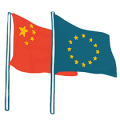

MERICS Forum: Chinese EV investments in Europe
On October 4, the European Commission’s proposal on tariffs passed the review of EU member states, with ten supporting, twelve abstaining, and five opposing. This approval adds tariffs between 7.8 percent and 35.3 percent on top of the existing ten percent levy on electric vehicles (EVs) made in China. Nevertheless, Brussels and Beijing are still discussing alternative solutions to the EU’s concerns over imports of China’s subsidized EVs.
The next step in the EU debate is to decide on the ultimate objective. While some member states oppose any further measures, others consider Chinese EVs a cybersecurity risk. Several countries also view the tariffs as an opportunity to incentivize more Chinese EV companies to localize their production in Europe.
Indeed, Chinese foreign direct investment (FDI) in Europe is increasingly concentrated in the EV sector, comprising over two-thirds of Chinese FDI in Europe in 2023. Hungary stands out, receiving 44 percent of all Chinese FDI in Europe in 2023, mainly due to EV investments. However, whether or under what conditions Chinese EV investments can ultimately be beneficial and safe for Europe remains an open question.
In this edition of MERICS Forum, Grzegorz Stec, Head of MERICS’ Brussels Office, asked several experts:
Are Chinese EV investments in Europe an essential boost or a brewing risk?
Jörg Wuttke
Partner at DGA Group; Former President of the EU Chamber of Commerce in China

Many European companies are worried about the growing number of Chinese EVs – with their competitive batteries and cutting-edge digital systems – arriving at EU ports on an increasingly larger fleet of car-carrier ships from China. The European Commission moved to slap tariffs on those cars to counter the significant subsidies and other support that China’s system provides its EV makers, including foreign brands like Tesla and German OEMs producing in China. Though the initial tariffs are minor, it is a clear signal for Chinese exporters that the EU may not remain indefinitely and unconditionally open. This could strike a blow to China-based EV makers that now face a growing number of markets pushing back on China’s exports, including the US, Canada, and Mexico and BRICS nations like Brazil and India.
One area to watch is investment along the EV value chain, which has defied the downward trend of Chinese overseas direct investment (ODI) and is estimated to have hit a record high in the last two years. The segment’s rapid growth has quickly caught the attention of concerned foreign governments. In 2023, the Indian government reportedly rejected carmaker BYD’s USD 1 billion plan to set up an EV plant in the country. In 2023, Australia blocked a Chinese investor from buying a larger stake in a local producer of dysprosium, an important mineral in EV production. It also blocked the sale of a lithium mine to a company operated by a Chinese national with connections to China’s mining industry.
How should Europe respond? The recent Chinese investments of battery maker CATL in Germany, BYD in Hungary as well as the partial takeover of the struggling car supplier Leonie in Nuremberg by the Chinese Investor Luxshare are actually good signs that Chinese companies can build up a supply chain that will not only benefit their original equipment manufacturers (OEMs), but the entire EV ecosystem.
Ágnes Szunomar
Senior Research Fellow at the Institute of World Economics in Budapest and Associate Professor at Corvinus University of Budapest

To reach its ambitious climate goals, including the 2035 zero-emission goals, Europe is investing billions of euros in electromobility, from encouraging car manufacturers to produce EVs, to supporting the sales of these vehicles, and installing charging stations. Although the EU now tends to see Chinese investment as a risk, it is difficult to imagine that this strategy could be implemented without the Chinese companies currently leading the EV sector.
The spread of EVs and EV companies will inevitably increase China's role and stake in the European car industry, reducing the share of manufacturers already established in Europe. Both the countries involved in automotive assembly and the home countries of the major European car manufacturers are vulnerable. They could be hurt if they completely cut off cooperation with Chinese companies (as they would not have access to spare parts and would limit consumer access to otherwise high-quality EVs), but also if they keep their doors open (as both subcontractors and larger manufacturing companies would lose out in an unequal competition).
European countries should also be aware that many of the critical raw materials for battery production originate from China, which could pose additional risks if China restricts access to them. Europe could secure its position by looking for alternative sources of raw materials supply, for example in Africa or Latin America.
When engaging with China, European countries should carefully consider the risk of their vulnerability to the automotive industry and ensure that future cooperation will bring more reciprocity as well as added value from local car assembly.
Jakub Jakóbowski
Deputy Director at the Centre for Eastern Studies (OSW)

Is Chinese foreign direct investment (FDI) in green technologies in Europe – as opposed to direct imports – bringing us closer to de-risking? I believe so, with several caveats. In principle, in these unstable times, bringing production to the EU’s home market makes sense, even if the investor is from China. Imposing tariffs on EV imports certainly gives Chinese producers a strong incentive to localize at least part of their production. The devil is in the details, though, and the possible benefits to the EU need to be actively safeguarded.
First, we need to ensure that FDI adds value and does not merely serve to circumvent tariffs through creating assembly lines. We need to demand more by requiring Chinese original equipment manufacturers (OEMs) to integrate their supplier base and preferably include EU suppliers in their value chains, spreading know-how and enabling technology transfer. Second, Europe needs to be strategic and ensure that Chinese producers do not gain an unfair advantage by sourcing subsidized components, like batteries, from China, undercutting European competitors. Third, both the production processes and final products need to be secure, especially regarding cybersecurity and data storage, adhering strictly to EU digital regulations.
In a nutshell, we should treat Chinese FDI the same way China has treated EU FDI for decades: what goes around comes around. For Western Europe, that will mean swallowing its pride and getting creative. For Central and Eastern Europe, it means a paradigm shift in their FDI policies, which should advance its industrial policy goals, and not merely bring jobs.
Gregor Sebastian
Senior Analyst at Rhodium Group

European Union member states have increased their scrutiny of foreign acquisitions, particularly those from China, in recent years. However, Chinese EV producers are showing new interest in investing in greenfield plants in Europe, sparking fresh debates about the benefits and risks of such investments. Greenfield investments – setting up manufacturing plants or research centers – have generally been seen as positive, bringing knowledge, jobs, and much-needed technology to Europe. In the case of EVs, they could benefit consumers through affordable EV models.
However, Chinese EV investment comes with several risks, some of which have been highlighted by Commissioner Valdis Dombrovskis and in Mario Draghi’s report on EU competitiveness. These concerns include a lack of value-added benefits, minimal technology transfer, low employment of local workers, increased reliance on China in a strategic sector, market distortions due to subsidies for Chinese producers, and cybersecurity and data risks.
With proper guardrails, the EU can, however, ensure that the benefits of Chinese EV investment outweigh the risks. These could include guarantees of local content, data localization, and stronger technology transfer requirements. However, implementing these measures will require significant political will, including potential reforms to the EU’s inbound investment screening framework.
Moreover, an evidence-based assessment of current and future Chinese investments will be crucial. Investments in EVs could range from cathode production to EV manufacturing plants, and each supply chain step may require specific tools and risk assessments. Properly managed, Chinese EV investments could be a valuable asset to Europe’s automotive sector.
Wendy Chang
Analyst at MERICS (Science, Technology and Innovation Program)

The prospect of Chinese EVs flooding the European market has raised many concerns, much of it focused on pricing and fair competition. However, foreign smart cars also pose significant data and cybersecurity risks that policymakers must address. And in that regard, inviting Chinese EV investments into Europe may complicate regulatory efforts.
To address security concerns posed by Chinese EVs, the US has proposed a ban on Chinese-made hardware and software components in EVs sold to the US market. While this may not be a solution that makes sense for Europe, there are elements of the proposal worth considering. A rigorous requirement for car companies to disclose their suppliers, particularly for key components, could be a good step to take. An example would be the TCU (telematics control unit), which is essentially a computer onboard connected vehicles that handles data transmissions as well as over-the-air software updates.
EU officials on digital policy have signaled that they share US concerns that data collected by EVs can be misused for surveillance, espionage and sabotage purposes. If the EU wanted to pursue a strategy where suppliers of key hardware and software components are scrutinized, Chinese companies with a cross-country footprint or ownership structures could find themselves in uncertainty. This adds even more complexity at a time when European automakers already need to replace their Chinese suppliers in their supply chain for the American market. While the EU tries to figure out its next move forward, it is hard to embrace Chinese EV investments in Europe without concern.
Alexander Brown
Senior Analyst at MERICS (Economy Program)

Chinese EV-related investments in Europe are more a boost than a risk. They contribute to developing the sector along the supply chain. The largest deals have been in battery production and are headlined by CATL’s EUR 7.5 billion investment project in Hungary. Yet the past year has seen several major announcements for new projects upstream in cathode and anode material production as well as downstream in final EV production.
China is the undisputed leader in battery technology and electric vehicles. The investments of Chinese firms in Europe provide capital, know-how and jobs. These contributions should be welcomed, so long as they adhere to European standards and a diverse pool of suppliers is maintained.
Crucially, there should be a balance between homegrown manufacturers and those from China or elsewhere producing locally, so Europe is not overly reliant on certain foreign companies. This risk appears to be manageable. Estimates suggest that by 2030, local battery makers will account for about half of all battery manufacturing capacity in Europe. Companies headquartered in China and South Korea are forecast to account for 20 percent and 14 percent, respectively.
Tariffs on Chinese EV exports to the EU will likely act as an additional incentive for Chinese firms to invest in Europe. A survey of Chinese EV companies showed that although business sentiment has taken a hit due to the anti-subsidy investigation, 64 percent still plan to build Europe-based factories within the next five years.

This MERICS Forum is part of the “Dealing with a Resurgent China” (DWARC) project, which has received funding from the European Union’s Horizon Europe research and innovation programme under grant agreement number 101061700.
Views and opinions expressed are however those of the author(s) only and do not necessarily reflect those of the European Union. Neither the European Union nor the granting authority can be held responsible for them.
